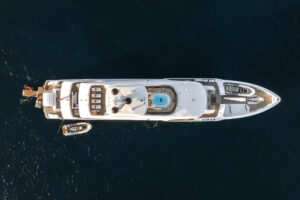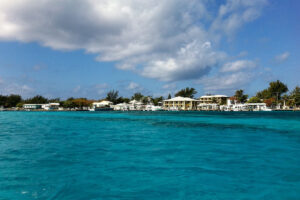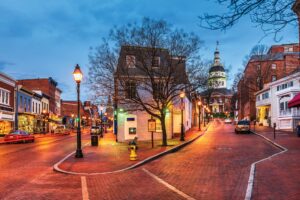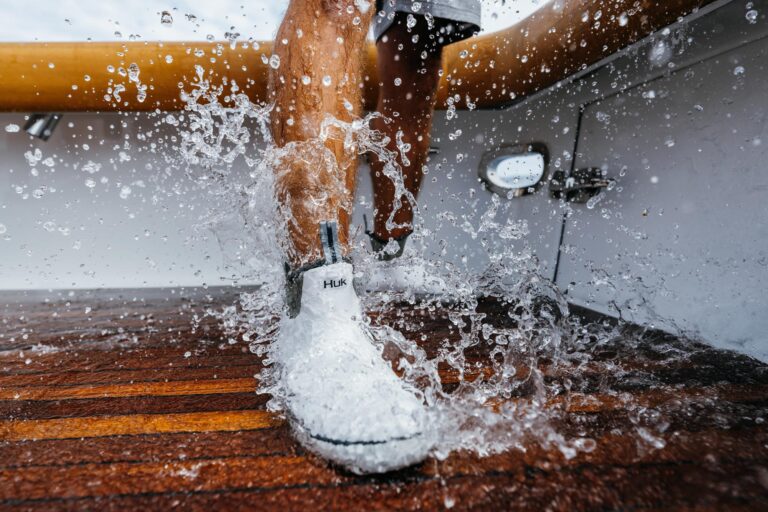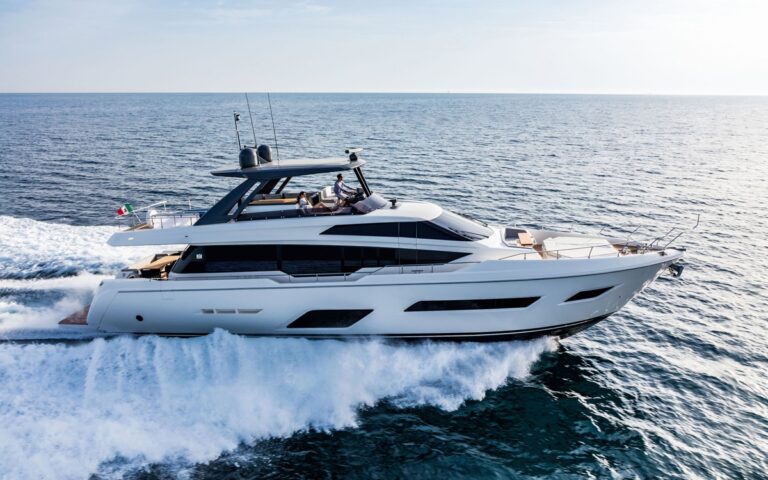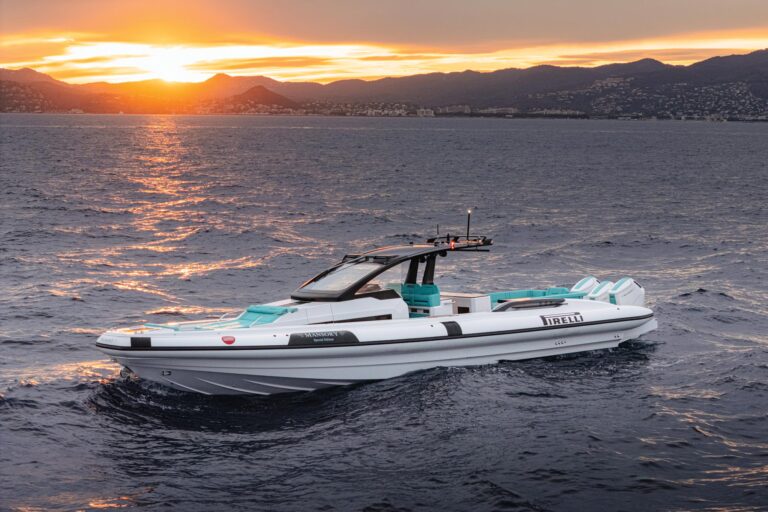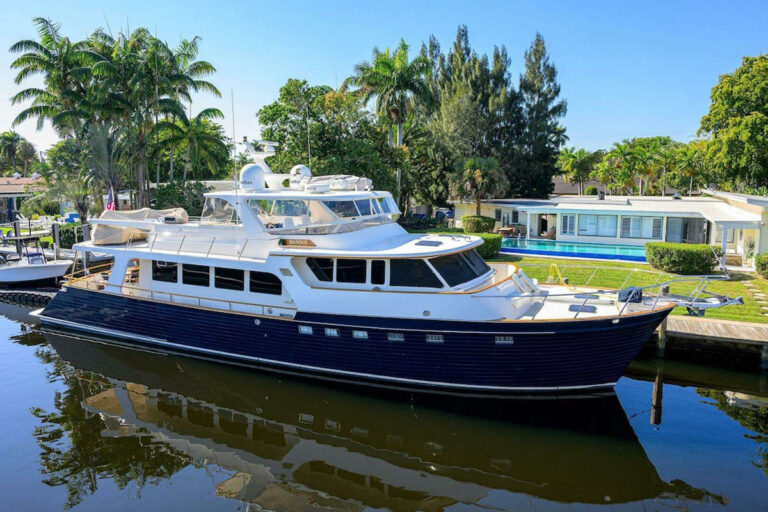The resolve to return one day to Dalmatia was 12 years in gestation-we cruised the area in l990. One is choosy about whom to spend seven days with in tight quarters, not that that’s entirely fair to say about Ynot (Yes. As in Why Not?) The 80-foot French-built sloop is truly grand, and tightness is experienced only on leaving the master head after a shower. The door opens inward, and egress requires a deep, stomach-intaking breath. Why did designer Bruce Farr do this to his commodious sloop? My fantasy is that the owner, seeking self-discipline, instructed the designer to come up with a fit that would deny him passage out of the shower into the rest of the ship and the great outdoors the day his girth increased by a single inch. Why not?
But that is a digression. Our objective was in three parts. The first was to locate a boat that would really move under sail while also providing the comforts aboard that fastidious people want who don’t want to cruise in powerboats. The next objective was to effect yet one more reunion of three couples whose steadfast friendship found us sharing a sailboat over the millennium. The third objective was to see again the Dalmatian coastline and the villages alongside, which have resisted great human efforts by kings and warriors who could do everything to Croatia except diminish its beauty and allure.
The six of us arrived in Split from various parts of the world and made our way to the boat. I met Van Galbraith when we were both freshmen at Yale, in l946. Three years earlier I had shared a single room at prep school with Alistair Horne. Van, fast recovering from a serious illness, has been busy in Brussels, providing for the common defense. He is, this time around, assistant to the secretary of defense for Europe, having served under President Reagan as ambassador to France. In between, he practiced law and banking. Alistair was in British intelligence, spending time in postwar Dalmatia. He went then to journalism and, soon, to the writing of history. When we joined up at Trogir he had just sent off to his publisher a massive history of Paris, for which he will certainly receive yet another award. I in turn had just completed a novel based on Ayn Rand (author and founder of Objectivism) and other difficult people. I was feeling hugely sorry for myself because, in August, pneumonia had set in, keeping me from my annual 10-day New England cruise aboard my beloved 36-foot sloop Patito, about which I have written that the boat is perfect for four people, and five people is three too many.
Ynot lay, captivating, on the waterfront promenade of Trogir, only five kilometers from the airport. If Disney had undertaken the job of jolting travel-weary passengers dusty from routine and uncertain health into another world, he’d have achieved, on a very good day, Trogir. The walled town has the waterfront and aboard the boat the late afternoon sun shot across the Kameriengo Fortress, on one wall of which is a huge red smear, red as in blood. I remember thinking that Disney was going a little far in historical melodrama-but there it was. And highlighted just forward of the boat a palace of sorts, one of a half dozen prominent features in the 15 acres of gnarled narrow stone streets. And of course a cathedral-14th century-and a second church. Alistair is a historian and drinks it all in. Others, raised in the non-Byzantine history of the new world, are willing to forget or to ignore who it was that the Apaches were quarreling with, back when Kotor was fending off the Turks. The modern tourist is free simply to walk about in the close streets, peer into the churches and castles, and maybe pause to wonder whose blood it was that was shed in defending, or assaulting, the Kameriengo fort. How long do bloodstains last? Was the blood Illyrian? Croatian? Venetian? Roman? Maybe Lady Macbeth was at Trogir once-everybody else seems to have visited here, and we were exultant to be among them.
Everyone who has chartered a boat and boarded it before nightfall wants to get under way. The itch to go is easy to understand when you arrive at your boat tied up in a marina in a thistle of a hundred other boats. But even pulling away from our royal single-boat quay at Trogir, there is the excitement of a boat springing to life. Van and I, who have crossed oceans four times together on my own boats, were especially curious to see Ynot under sail and the captain proposed a short (12 kilometer) excursion to Milna, on the island of Brac. That leg would permit us, in the southwest wind, to hoist sail and feel our great steed in action. No boat I had ever owned or chartered before had power winches, so I stared rapt at the scene where, without any hand pulling on any line or turning any winch handle, the mainsail crawled up to the top of the mast, and the great genoa unbound. It was as if the industrial revolution was taking place right there in the Splitski Kanal, before my very eyes.
We were in Milna in a couple of hours, and walked about the fishing village with its soft yellow lights arcing over the horseshoe-shaped harbor front. We must move on or we won’t have time to visit Vis or Havar or Korcula or Peljesac or Kotor-let alone Dubrovnik.
We ate dinner on board, resourcefully prepared by the captain’s wife, Ann, helped by Nicky Moss, a young woman bent on seafaring, and by veteran seaman Randy West, resident of St. Barths. There was a novelty in our dinner arrangements. I have chartered boats every year since l959, and was never before given the Ynot option. The captain’s proposal reached us during the summer, via agent Julie Nicholson. Traveling, as you intend to do, from Split south to Kotor and back up to Dubrovnik, he wrote, you will find yourselves every night in attractive Dalmatian villages with varied and attractive local restaurants. If you decide you want to eat ashore one night, or more, Ynot Inc. will reimburse you $30 per person, per meal. We found the option attractive, and exercised it every night, except for this first night at Milna. The fare uniformly stressed the fish from surrounding waters. Veal in its various forms is always there, but most memorable, the mussels, heaping onto plates burning hot oil and butter and herbs. The Croatian wines are famous (Zinfandel is said to have begun there), and we liked especially the Radonic and Plegivica). The first restaurant was candle-lit, the service good, the waiters, English-spoken; seating arrangements there, as almost everywhere, permitted diners to sit outside. The $30-a-plate subvention proved just about right, covering most of the cost of dinners, good and not so good. This isn’t a serviceable idea for cruising just everywhere. You wouldn’t want to find yourself dependent on finding an attractive local eating place in stray Grenadine islands, or in Baja California, or, for that matter, in every Greek island or Turkish harbor.
We had fine weather every day but a disappointing lack of sailing winds. We had the sails up going southwest to Vis, but they flopped about, the genoa brought in after only an hour or two. Vis has the allure of the forbidden island. It was a military base for the former Yugoslav army. Josip Broz Tito hid out there during the war, discreetly protected by intermittent sallies of the British air force. At Komiza, on the western side, is a picturesque harbor, with vendors along the wharves and fishing boats tending to their concerns. Tourists are welcome and greatly needed. Tourists came in abundantly before the war, 10 million per year to Croatia, and the trade is almost back to normal, but although Vis is acknowledged as one of the most beautiful of the coastal islands it isn’t heavily visited, and indeed, up until l989, was off-limits.
The most alluring phenomenon is just off the island at Bisevo, where the Blue Grotto holds forth. We were there a dozen years ago, and Van swam into it at just the right moment, when the sun’s rays penetrate an underwater opening and flood the interior in an intense, ephemeral (the sun rays are admitted, then blocked after just one hour) blue illumination that gives the sensation of occupying your own personal grotto. Below you (this is snorkel time) is Dalmatian water, unsparing in its clarity. You are inside the grotto and the water is protected, so the surface is flat as a mirror, the rocks a stuttering pink and yellow.
We didn’t swim a whole lot on this trip. The water temperature is fine, the first week of September at Latitude 43 North, Longitude 16 West. But bear this in mind, you aren’t there for beach life. There is everything beautiful and intriguing in the rocks and coves, but enticing beaches are rare, their surfaces crusty. I remember several sailing trips in my beloved Azore Islands, which have everything except sandy beaches. They are gray. The man in charge of tourism for Vis and Korcula would profit from the initiative of the fabled advertising agency in the 1930s, hired to help unload a huge supply of salmon from British Columbia, unaccountably and dismayingly snow-white. The agency came up with the label, “Guaranteed Not to Turn Pink in the Can. Yugoslav beaches are guaranteed not to turn white on you.
I found myself especially eager to see Kotor again, though the islands en route are, each one, worth visiting and exploring. At Korcula we met for dinner Alistair’s friend, Veronica Maclean, the learned widow of Fitzroy Maclean. Herself an author, she elected to continue to live, in the summers, in the house just behind the cathedral in the glamorous walled city liberated from the Nazis by Tito, the dashing author, politician, soldier Maclean alongside. The temperature of our animosity to Tito, tyrant, has cooled since the bloody dissolution of the amalgam he held together for 30 years. Rounding the point to enter Korcula I was summoned from below. My wife reported a sea battle going on. And indeed that was so, with 5,000 viewers lined up along the city walls, booing and applauding. It is an annual spectacle, a half dozen wooden ships with sails and oars in l3th-century dress, with great smoke issuing from whatever synthetic ammunition they had got hold of. It was the famous sea battle between the Venetians and the Genovese. The prize? Marco Polo himself, captured there, and imprisoned in Genoa. He sat down in jail and wrote his memoirs.
The schedule on this cruise was easygoing. Breakfast whenever individual passengers rose to have it. Then for two or three hours we’d wander about the town we were visiting, or stay aboard and read (Sheelin Horne did watercolors, Bootsie Galbraith took photos). Sometime around noon, we would start the day’s journal, lunch served while under way. The sail that took us along the island of Peljesac, around the estuary, then up the Ston canal was perfect, Ynot showing her grace under wind pressure of 18 to 20 knots. At Ston there was the great wall to see, 5.5 kilometers, the longest fortification in Europe built to protect the critical salt supply.
We headed southeast, sliding by the tip of Croatia up-in Montenegro territory now-into the two-mile-wide bay that winds north, then east, then north again, and yet again east, eight miles of this with mountains and pastures and villages, and you are in Kotor. We got in just as dark fell. We had had then, powering smoothly down Kotorski Bay, an hour of straitening daylight and the flickering on of land lights, decorating the darkening mountain ranges like candles at the base of vaulted cathedrals. We reached, at the bay’s end, the city that withstood the Turks and preserves its lively Old Town, encircled by a 2.8-mile wall. Etched over the stone entrance portal is a magic date: November 21, 1944. That was the day the Nazis, who had succeeded where the Turks had failed, were finally routed.
We were eager to revisit the two picture perfect little islands, side by side, off Perast, discerned only faintly yesterday in the falling light. They are staunchly there. Our Lady of the Rocks, about the size of two tennis courts, still has its baroque church and a museum now, with a guide to take you about. Gospa od Skprjla, the companion island, is 50 yards separated, the church dwelling set off by giant cypress trees. We approached it gingerly by dinghy. A dozen years earlier we had touched down there into the company of two reclusive nuns who tended the little seminary and the little garden and the trees. Would they still be there?
We walked toward the entrance door on the north side. Rounding the corner we stared down at a sunbather. Her eyes were closed, her bra lay at her side. She proved slow to rouse from her sleep, then amiably informed us that the ancient property, abandoned, had been acquired by a family in Serbia who left the building locked, opening it only for special occasions. Our informant, we learned, arrived by swimming the 300 yards from Perast. There was nothing more to see than what lay before our eyes. Legend has it that the island had been nothing more than a small reef and that on June 22, 1452-one year before Christopher Columbus was born-two brothers fishing on the spot came upon an image of the Madonna. In veneration, they filled the reef with rocks and built the church. The nuns we spoke with in 1990 told us that life had been hard, that during his reign, Tito had executed 450 clergy. There is no one left, at Gospa od Skrpjela, to persecute, and worship there is of the sun.
Retracing our passage out of Montenegro, destination Dubrovnik, we looked diligently with binoculars hoping to find the Club Med facility we had paused at (Van was a director of Club Med) when it was newborn. It had been thriving with vacationers, and we passed an hour with three Dubliners celebrating the end of their medical school. They were loving it there, at the San Marco Club, though it was a little Spartan, offering no electricity in the individual huts. As we approached today, we could discern more than 50 of these eggheaded thatch huts. Coming in closer, we saw that the entire camp had been abandoned. Three natives were chatting in trunks at the old wharf, one of them a polyglot who advised us that we were free to address him in any of six languages. He told us that the Club Med had closed down during the war, and never revived after the cease-fire. We walked about the spooky ruins. The outdoor dining hall still has its tables, decomposing now, and behind is a crestfallen stage where old posters and rosters and vestiges of exuberant outdoor life hang.
A mere nine years had brought on the near total disintegration we surveyed. The church we had just left had had life for 550 years, and will survive in brick and mortar, whereas the San Marco Club four miles distant will no longer be traceable, unless you arrive with a GPS fix. If you are looking for it, you will find what is left of it at 18 40.6 N, 42 24.2 W.
We powered (no wind) northwest, having decided to spend the final night on Ynot in Cavtat, which is, incidentally, right by the airport used when flying into and out of Dubrovnik. It is a harbor shaped as if replicating the end of a wrench, and provided security against everything except the noise of aircraft traffic. We’d leave the fabled Dubrovnik, which is all but entirely repaired from what it suffered during the war, for the end. Cavtat suffers from a huge modern hotel, overlooking the harbor and indeed Dubrovnik. It is so hideous we debated walking over to it to learn who had designed it, desecrating that view of the harbor. Perhaps another war will dispose of it. Until then, one can only look away.
Last nights together encourage a little rumination. Everyone pledged to do it all again, on that particular boat, if lucky, with the same crew. Afterthoughts? I had a couple. In the general flurry of departure I had forgotten to bring a few items critical to my complete contentment when cruising. Never leave without your own GPS, which gives day-by-day, sometimes hour-by-hour satisfaction as you fuss over the charts and sight that mountain peak. Bring your own binoculars-why not? There was only a single pair on board, and we were 10 people, including the crew. Finally-and this is a little cumbersome-Bring a radio-cassette player (I’ve used a yellow Sony Seamaster for 30 years), which will let you adjust the volume from where you are sitting. Central volume controls operated in the main saloon aren’t good enough. And bring then 30 tapes or CDs of the kind of thing you especially like. All of the above can be crammed into one accommodating briefcase. And of course-and this one, none of us neglected-bring your own friends.
That night everyone wrote out checks to reimburse the treasurer their share of expenses. The basic cost of Ynot is $3,000 per day. Merely to mouth the figure brings on shudders, but then also heightens the enjoyment; anything so costly had to be special. There is the ensuing deconstruction of the gross figure, in search of reassuring perspectives. It boils down to $500 per person per day, which sounds a lot more digestible, and in turn invites reassuring thought on comparative indulgences, like a day and night in Hong Kong, or on a luxury liner, or-what the hell. Five hundred doughnuts at $1 apiece.
Moral? Work hard, and disinherit your grandchildren.
William F. Buckley, Jr. is a frequent contributor to Yachting and author of the novel Nuremberg: The Reckoning.

